As Devorah Halberstam, a prominent local activist, drives through Brooklyn’s Crown Heights neighborhood in her white 2017 Acura, she grows increasingly animated. Cruising Kingston Avenue at the end of the summer, she rolls quickly by community landmarks: Ess & Bentch Glatt Kosher Takeout, Raskin’s Kosher Fish Market, Weinstein Hardware and Gombo’s Heimeshe Bakery. We cross Eastern Parkway, where multiple Black Lives Matter (BLM) protests have come marching through, then come to a banner strung from one side of the street to the other, fluttering above the road. “Moschiach [the Messiah] is on the way!” it exhorts. “Be ready!”
“Kingston is the Jewish business center but people of all backgrounds are walking around.”
But Halberstam is touting neither the protests nor the coming of the Messiah. “We’ve become a neighborhood!” observes Halberstam, whose oldest son was murdered in a religiously motivated shooting on the Brooklyn Bridge in 1994. “Kingston is Crown Heights’ Jewish business center,” she notes. “But people of all backgrounds are walking around.” She points out men in white shirts, black coats and kippot from the Lubavitch Hasidic sect, which has made Crown Heights its international center since the 1940s, and their spouses and daughters in long skirts; but also, Black families with their children strolling casually, young white 20- and 30-somethings on bicycles with helmets firmly affixed. One youthful white couple is window-shopping, pushing a sleek Baby Jogger stroller. “Yuppies are moving in now,” says Halberstam, adding gentrifiers to the mix of Blacks and Jews who have lived in Crown Heights for decades, amid many ups and downs.
The downs include one of the darkest episodes in New York’s history: the accidental killing in 1991 of a Black child by a Hasidic driver, followed by three days of attacks on Hasidim in Crown Heights by throngs of African Americans, including the murder of 29-year-old Yankel Rosenbaum, an Australian scholar living and working in the neighborhood. The attacks began after a Lubavitcher in the motorcade of the sect’s leader, Rabbi Menachem Mendel Schneerson, ran over and killed seven-year-old Gavin Cato, an Afro-Caribbean boy playing in front of his own home, reportedly after the driver ran a red light. Gavin’s playmate and cousin, Angela Cato, also seven, was seriously injured. Onlookers were outraged when an emergency vehicle from the Jewish ambulance service Hatzolah appeared quickly and took away the Hasidic driver and his passenger, who were both slightly injured, while Gavin and Angela remained prone on the street until a city ambulance arrived for them. According to the Girgenti Report, an exhaustive investigation of the riots ordered by Governor Mario Cuomo, it was not Jewish favoritism at work; police on the scene, seeing the crowd’s rising anger, urged the ambulance crew to take the two Hasidim away as fast as possible.
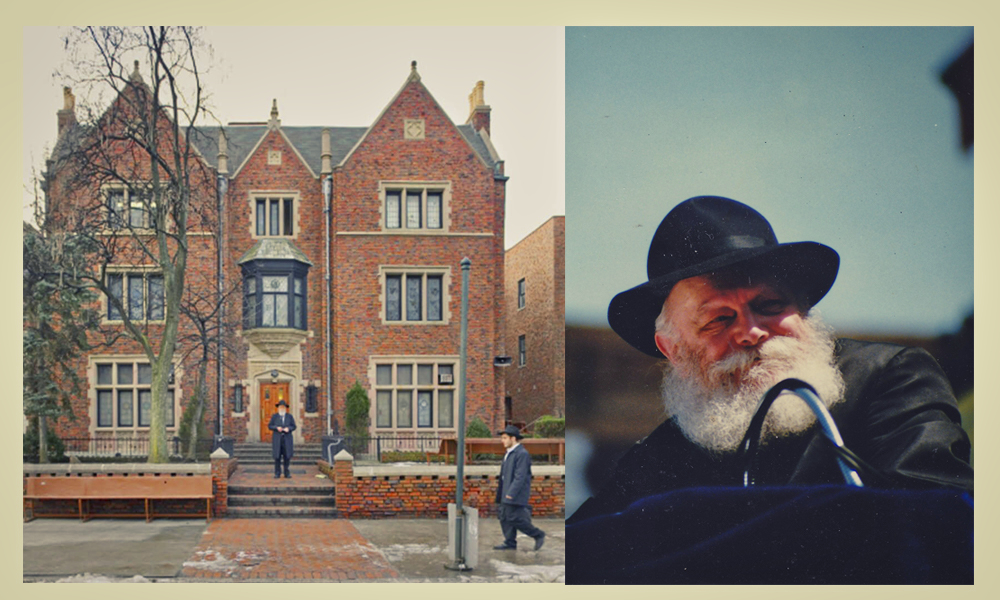
Left: 770 Eastern Parkway, also known as 770, is the street address in Crown Heights of the World Headquarters of the Chabad-Lubavitch Hasidic movement. Right: The late Rabbi Menachem Mendel Schneerson. He encouraged his followers to remain in Crown Heights. (Photo credit: Wikimedia)
Since then, there’s been bridge-building and often difficult dialogue between leaders and grassroots members of the two ethnic groups. Nevertheless, angry disputes continue about the rightful distribution of government resources between the majority Black community and the Lubavitchers, who are often better organized. The role many Hasidim play as landlords in Crown Heights also breeds resentment among some. The influx of whites now gentrifying the community, meanwhile, has increased the cost of housing for both groups.
And from late last year through February of this year, a series of anti-Semitic attacks, some of them violent, committed by African Americans have roiled the Lubavitch community. In fact, gun-related crimes of all kinds, while trending down over the past decade, have recently spiked in Crown Heights, as they have in the entire city.
All this may seem to contradict Halberstam’s bright picture of Crown Heights. But according to other community members, the situation is more complicated. At the leadership level, explains Yaakov Behrman, a Lubavitch community activist who directs a substance abuse education program in public schools and yeshivas, relations are close. He says Black and Lubavitch homeowners, in particular, share a strong sense of investment in the community.
“We’ve come a long way since the riots, when there was a real leadership problem,” says Behrman. When tensions exploded then, no one on either side knew anyone on the other side. “Now we can call each other,” he explains. “But on the streets, at the grassroots level, there are real problems with anti-Semitism.”
Against this backdrop, the BLM protests coursing through Eastern Parkway, the neighborhood’s wide, tree-lined central artery, appear to have aroused diametrically opposed feelings in Black and Jewish communities—raising hopes for many in the former and stoking fears among many in the latter.
Most Lubavitch Crown Heights residents are quick to say their views of the BLM movement have nothing to do with any tensions between the Black community and the Lubavitch community. BLM is aimed at police, after all, not Hasidim. Still, many of the Hasidim worry that the reforms BLM seeks will tie the cops’ hands, leading to more crime in a neighborhood where gun violence is already rising markedly. Members of the Black community, meanwhile, speak about years of being targeted by the police based on their race.
This split may not differ much from the way many Black and at least some white Americans view the movement across the country. But unlike much of America, Crown Heights’ Black and white residents live cheek-by-jowl as neighbors. What that means today as the BLM movement impacts this community is pivotal because, contrary to the laws of physics, in Crown Heights, the two groups inhabit the same space at the same time, and yet live in two completely separate universes.
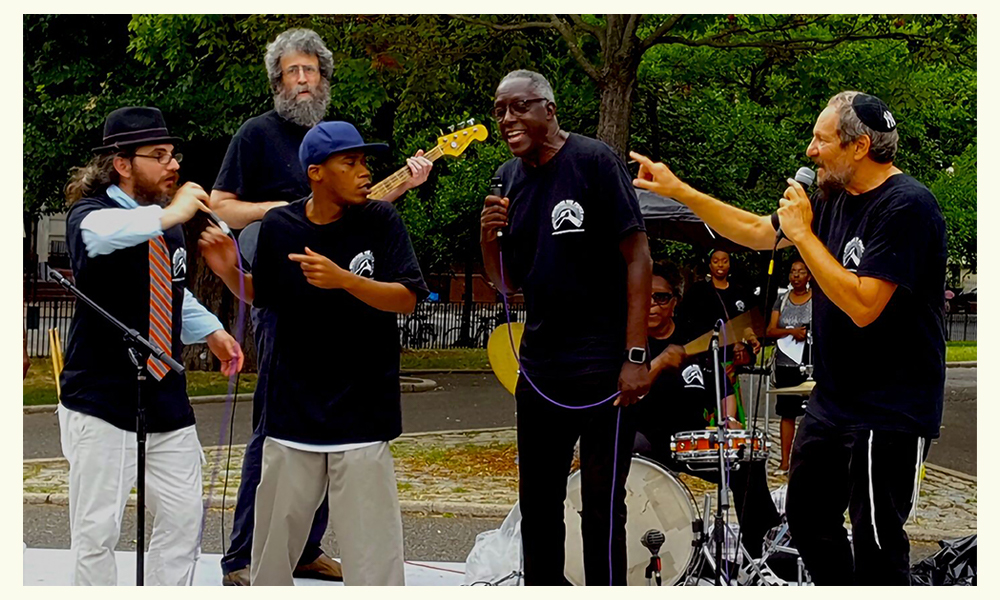
Richard Green (center singer) and David Lazerson (right) perform with “CURE,” a band the pair created to ease racial tension in the neighborhood. (Photo credit: Courtesy of dr. laz.com)
The Lubavitch sect—also known as Chabad—first came to Crown Heights fleeing Europe during and after the Holocaust. The tattered remnant of a vibrant movement that was founded in present-day Belarus by the Hasidic leader Rabbi Schneur Zalman in the late 18th century, these refugees found sanctuary in a mixed neighborhood of overwhelmingly white, predominantly Jewish residents, with pockets of Italians, Greeks, Irish and Blacks from both America and the Caribbean. The sect’s leader, Rabbi Yosef Yitzchok Schneerson—known as “the Rebbe”—took up residence in a large Gothic Revival-style house at 770 Eastern Parkway in 1940 and declared the building Lubavitch World Headquarters.
That must have seemed grandiose at the time. The group had been decimated by the Nazis’ mass slaughter, and their numbers were small. The overwhelming majority of Jews in Crown Heights were non-Hasidic, ranging from Orthodox to Conservative to Reform and, mainly, secular.
But this all changed dramatically in the late 1950s to mid-1960s, thanks mainly to one man: Robert Moses, New York City’s all-powerful urban planner from the 1930s into the 1960s. As with so many other neighborhoods, Moses’ vision transformed Crown Heights.
Above all else, Moses was devoted to a postwar ideal of suburbanization. In fact, he practically invented it. And that goal meant, among other things, an imperative to transform New Yorkers’ mode of transportation from trains and buses to cars. Cars, of course, need roads. So Moses planned and oversaw the construction of new highways and massive bridges to speed millions of commuters along. For residents of Manhattan, Queens and the Bronx, there was the towering Triborough Bridge complex, linking these three boroughs to each other and all of them to Grand Central Parkway, which, under the name Northern State Parkway, becomes six well-paved lanes cutting deep into suburban Long Island. For Brooklynites, there was the Brooklyn-Queens Expressway and, conveniently connected to it, the same Northern State Parkway, providing them, too, with easy access to Long Island.
Suddenly, Crown Heights Jews saw a way out of cramped apartments and crowded streets, via these modern highways, to bucolic homes with attractive lawns and space of a kind they could barely have imagined before World War II. Thanks to the GI Bill, the National Housing Act of 1949 and America’s booming postwar prosperity, generous federally guaranteed mortgages were available almost for the asking, enabling them to move to new, affordable, planned Long Island communities. Levittown, the sprawling series of development projects that William Levitt constructed almost by assembly line to take advantage of this new market, was one of the most alluring draws.
Black residents had no such opportunity. There were, to be sure, no Jim Crow laws on New York’s books; none were necessary. In its regulatory provisions, the Federal Housing Administration, which administered federal loan guarantees under the National Housing Act, recommended that “suitable restrictive covenants” be included in deeds for homes bought with these loans to avoid “inharmonious racial groups’’ in housing. The local banks, which actually gave out these loans, routinely refused mortgages to Black applicants. In New York and the northern New Jersey suburbs, fewer than 100 of the 67,000 mortgages insured by the GI Bill supported home purchases by non-whites. Just in case, Levitt, following the FHA’s lead, included racially restrictive covenants in the deeds of all of his developments.
Unsurprisingly, Black residents, by and large, stayed put as whites fled integrated neighborhoods such as Crown Heights. This, in turn, created lots of newly available housing in Crown Heights. There, strangely enough, the banks were willing and ready to approve Black loan seekers. In fact, many Black New Yorkers were in dire need of housing then. In the seven years following World War II, an estimated 68,000 to 100,000 Black and Hispanic New Yorkers were evicted from their homes—mainly to make way for Moses’ highways and other public works projects. During the 1950s, Brooklyn’s Black population increased from 240,000 to 340,000, with approximately 340,000 whites leaving.
This was the genesis of Crown Heights as an urban ghetto. The change was astounding: In 1960 the neighborhood was 70 percent white, by 1970 it was 70 percent Black. And it was the New York Police Department that was pressed into service as the guardians of this arrangement.
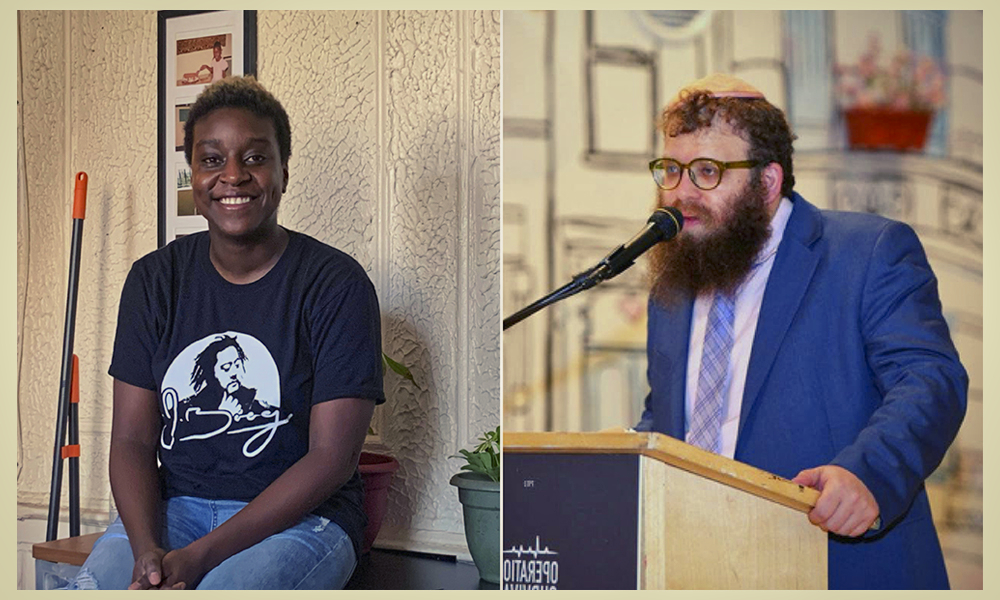
Left: Crown Heights resident Dasne Darnelle. Right: Activist Yaakov Behrman. (Photo credit: Itzik Roytman, Larry Cohler-Esses)
One group of whites, however, refused to leave. If Black New Yorkers were basically corralled into the neighborhood, the Chabadniks’ presence in Crown Heights was (and remains) the product of a sacred, quasi-religious commitment. In 1969, Rabbi Menachem Mendel Schneerson, who had become Chabad’s new Rebbe in 1951, declared “the wholesale emigration from Jewish neighborhoods” to be “a plague.” Citing religious sources, he decreed it a religious duty for Lubavitchers to remain in Crown Heights.
According to the co-author of a definitive biography of Schneerson, the Rebbe’s driving concern was assimilation. “He was convinced that as long as his Hasidim remained in a neighborhood where the others were so different and lived a life that had no attraction [for them], he’d not have to worry about the possibility of their wanting to be like them—something not true for Jews living in middle-class white Jewish suburbs,” says Samuel Heilman, a sociologist at CUNY.
By now, the haggard group of refugees that had arrived in the 1940s had grown exponentially. Primarily in fulfillment of the biblical command to “be fruitful and multiply,” Lubavitch families often have anywhere between five and ten children. Schneerson imbued his followers with a new sense of mission. Under his leadership, Chabad emphasized as never before the imminence of the Messiah’s arrival and, along with it, a powerful mandate to actively evangelize other Jews to perform mitzvot, or commandments, to hasten his coming. In New York, Lubavitchers became ubiquitous in their long black coats and black hats, waiting in pairs at train stations and other public places, where they tried to identify Jewish-looking males walking by and get them to put on tefillin—one of ten basic “beginner’s mitzvot” the Rebbe identified as ideal for introducing non-observant Jews to the concept of mitzvot. (Most of the other nine mitzvot—for which Chabad has separate campaigns—focus on rituals and practices that must take place in the home or synagogue.)
Under Schneerson’s charismatic direction, Chabad took its missionizing global. From college campuses in America to remote outposts such as Pokhara, Nepal, young Lubavitch couples spread out into the world, to wherever they could find Jews, however few, who might be in danger of assimilating.
They established Chabad Houses in these locales, where they offered Orthodox Jewish hospitality and services to any Jews living nearby or just passing through.
Chabad-sponsored congregations sprang up in many cities, drawing a wide spectrum of Jews who were not themselves part of Chabad, or often even Orthodox. This has transformed Chabad into something unique: ultra-Orthodox Jews set, like most such groups, on living lives insulated from much of modernity—but at the same time using modernity’s tools of sophisticated mass marketing, slick media and relentless personal outreach to broadcast their message. Today, the movement claims to operate 3,500 institutions in 100 countries.
By the time the Rebbe died in 1994, he had become an object of increasing adulation, perhaps the Messiah himself in the view of many Lubavitchers. (A significant faction even today believes he didn’t actually die; rather, they assert, he is remaining hidden until the time is right for him to return openly as the Messiah of biblical prophecy.) The house at 770 Eastern Parkway has remained the sect’s World Headquarters, despite the fact that Schneerson, who died childless, left no successor to take up residence there. Administrative oversight of the sect’s sprawling enterprise has, meanwhile, fallen to several senior rabbis who work out of the Crown Heights headquarters, although no one has assumed the Rebbe’s spiritual authority.
Although the movement is run from Crown Heights, the neighborhood itself is today far from Chabad’s central focus. Estimates of Lubavitch’s membership worldwide run from 100,000 to 250,000, but only some 15,000 to 25,000 are believed to live in Crown Heights. The most recent data available, from 2011, put the number of Jews, mostly Chabad, in Crown Heights at just 22 percent of the neighborhood’s population.
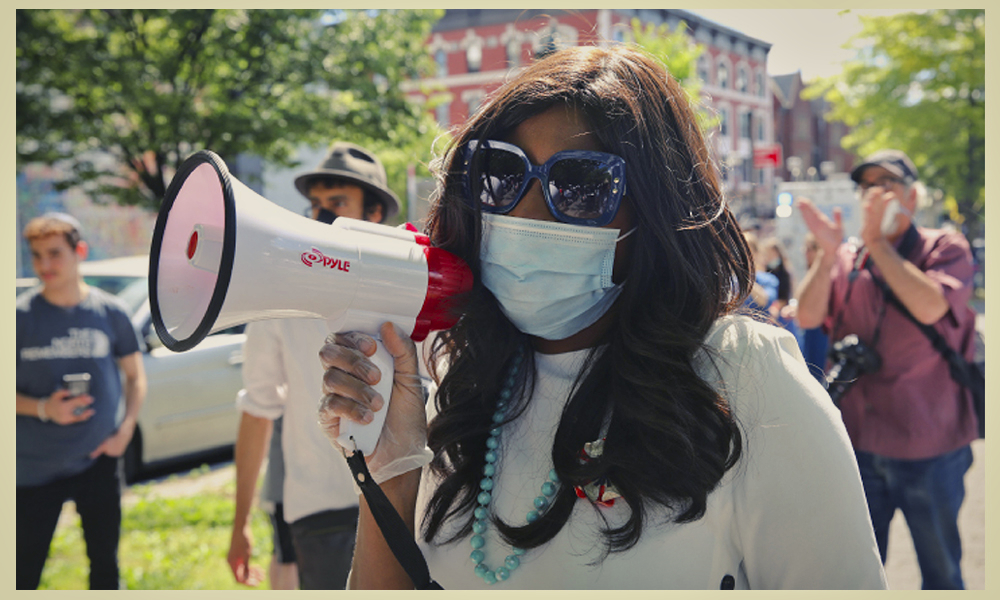
Protest organizer, Maayan Zik. (Photo credit: Itzik Roytman, Cohler-Esses)
The different routes by which Crown Heights’ Black and Hasidic residents arrived in the neighborhood—one through racially engineered urban planning, the other finding refuge there after a narrow escape from a historic tragedy—make for huge, almost existential, differences in the way each group experiences life there today.
Even before the riots of 1991, this, along with Chabad’s inherently insular lifestyle, made it hard to imagine any meaningful way to bridge their two universes. Few even considered this an important goal. After 1991, it was even harder—but a few in each community now considered it crucial.
David Lazerson, now 70, and Richard Green, who is 76, were among the first individuals to take on this challenge for their respective communities, just ten days after the riots. In the aftermath of the violence, “Crown Heights was like a war zone,” Lazerson recalls. “Cops were everywhere.”
Lazerson, who grew up non-Orthodox before joining the Chabad community, volunteered to lead the Lubavitch end of a dialogue between Black and Hasidic residents that the administration of Mayor David Dinkins was trying desperately to get off the ground after the riots cooled down. With a master’s degree in special education, Lazerson had taught for years in the public schools of Buffalo, New York, where he was deeply involved with Black students, their families and their community.
“We’ve come a long way since the riots but…”
Green, who is Black, moved with his family to Crown Heights when he was just 10, to a home directly across from Rabbi Schneerson’s residence and Chabad headquarters at 770 Eastern Parkway. “I was always fascinated looking out the window and across the street on Sabbath,” he says. But he learned little about the residence’s inhabitants or their beliefs.
In 1977, Green founded the Crown Heights Youth Collective, which provides counseling, recreation and career and employment development assistance to local youth. In that capacity in 1991, after the riots, Green agreed to bring a group of Black youths to meet with a group of Hasidim, at the city’s request. The meeting took place at the Brooklyn Science Museum.
“It was like the Sharks and the Jets,” Lazerson recalls, “and the museum was neutral ground.” But he and Green found they were able to bond early over their shared love of music from the 1960s. At that first meeting “all the stereotypes came out,” he says: “You control the media, and you’re all rich,” one group charged. “You’re all drug dealers and don’t do anything productive with your lives,” said the other.
When some Hasids said they were on food stamps, Blacks were disbelieving, the two men recall. Several Hasids “snickered,” Lazerson relates, when a few Black participants said they had to leave early for violin lessons. “I was amazed to learn what they didn’t know about their neighbors,” he says.
From this first meeting and many that followed, the idea eventually germinated for Project Cure, an initiative that brought the two groups together through music and basketball. Black and Hasidic Project Cure members began playing basketball together, including a 1993 scrimmage during halftime at a New York Knicks vs. Philadelphia 76ers game. A hip-hop group got off the ground with Green and Lazerson, who adopted the persona “Dr. Laz.” The group released a CD and was the subject of a documentary. Green, Lazerson and their cohort soon found themselves on the hugely popular Phil Donahue and Montel Williams talk shows.
Separately, in the months following the riots, Brooklyn Borough President Howard Golden brought leaders together from each of the communities to create the Crown Heights Coalition, a forum for airing neighborhood issues and launching inter-ethnic projects. One initiative sent Jewish and Black leaders into public schools to answer student questions about each group’s culture.
These initiatives had an impact. Today, many Lubavitchers talk about friendships they have with their Black neighbors. But it’s not clear if the Black community views these relationships in the same way. Few Black residents mentioned this in interviews. Yvette Clarke, who is Black and Crown Heights’s Congressional representative, cites “the insular nature of the Lubavitch community” as a continuing hurdle.
“It’s very hard, even from a gender perspective,” she says, referring to the restrictions on interactions between women and men that Chabad members observe among themselves and with outsiders. “Ultra-Orthodoxy doesn’t permit a lot of secular interaction, and that makes it extremely difficult.”
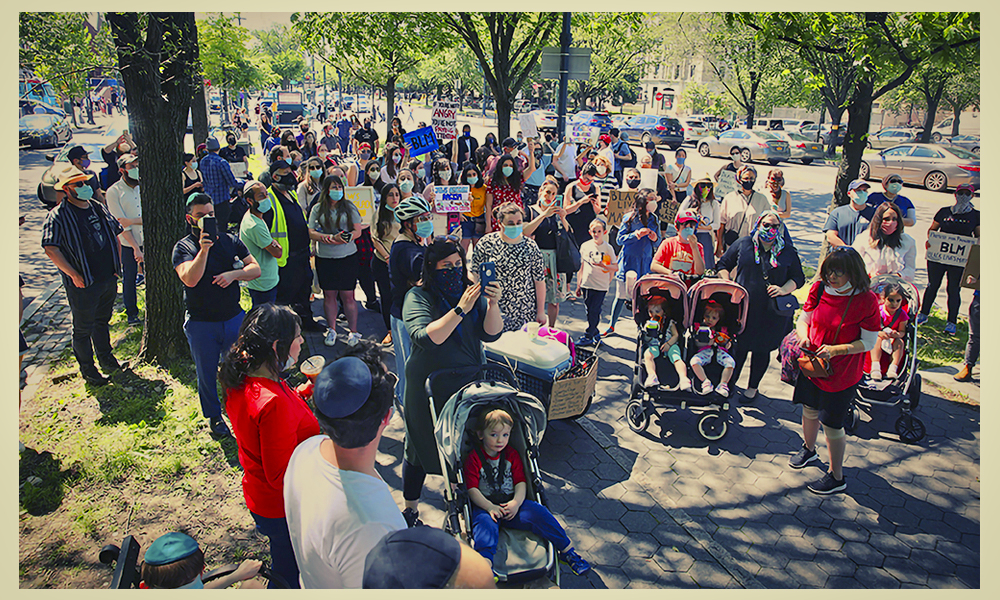
Protesters gather in Crown Heights to support BLM. (Photo credit: Itzik Roytman, Cohler-Esses)
This past July, New York Mayor Bill de Blasio disbanded the city’s special
anti-crime units, partly in response to Black Lives Matter. The units, plainclothes cops who operated undercover to find and arrest people with illegal guns and stop violent crimes in the city’s highest crime areas, were a kind of elite frontline troop. Most Black residents were relieved at their disbandment, most Hasids the opposite.
Credited with taking thousands of illegal guns off the streets, these units were known for their aggressiveness. They were responsible for 31 percent of all fatal NYPD shootings since 2001, according to a 2018 review by The Intercept, an online publication. Yet its members made up only about 2 percent of the force’s active detectives and officers on patrol. Asked her feelings about the units’ abolition, Rep. Clarke exclaims, “I say, thank God!” She adds, “I watched as those units did massive stop-and-frisks.” Clarke, whose parents emigrated from Jamaica, is speaking about the units’ policy of aggressively stopping and searching people as young as 13 in high-crime neighborhoods for making “furtive” movements. “They would show up in plain clothes and terrorize young people in the community,” she says. Reverend Paul Chandler, a longtime Black Crown Heights resident who was also a co-leader of Project Cure, observes, “There’s just a difference in the attitude police have to Jews and to Blacks here.
If I’m stopped for running a red light, I’m asked to get out of my car. But if I’m a Jew with a black hat or a kippah, I get a pass. Trust me on this—because they see me as less than human.”
“That’s a lot of what you hear,” says community Hasidic activist Behrman. “‘The Jews get away with everything. The cops side with the Jews.’” Behrman notes several times that his parents, who came to Chabad from the secular world, had “a civil rights” background. “I was brought up understanding that both our communities are oppressed,” he says. “There is an issue of hate in this country. I won’t deny that Blacks have told me their kids are scared of the police. I don’t think that’s OK.” The killing of George Floyd by police last May in Minneapolis, he says, “horrified” him. Behrman deplores de Blasio’s decision to disband the special crime units, saying it will inevitably lead to more guns and more crime. “There’s a feeling of lawlessness in the streets,” he says. “People in the neighborhood have no problem setting off fireworks until 2 or 3 a.m.—dangerous fireworks where people are at risk. I know two cops who work with the Black community whose car was firebombed with a Molotov cocktail.”
In Behrman’s opinion, Black Lives Matter “has taken a just cause and turned it into a dangerous agenda with extreme program proposals” such as “defunding” or even “abolishing” the police. “If Black Lives Matter wants to have a real conversation about prevention and reform, I’ll be there at the table,” he says. “But we’ve had a dozen shootings here lately.”
The rise in gun crime is serious. Shootings and shooting-related deaths have skyrocketed since the beginning of 2020 in the 77th Precinct, which encompasses a large swath of Crown Heights. In 2019, there were 15 shooting incidents resulting in 16 deaths between January and late July. This year there have been 28 shooting incidents and 31 deaths in the same time period—nearly doubling the count in each category. Thirteen of those 31 deaths this year took place between July 1 and July 19.
Chabad Jews in Crown Heights also point to the surge of anti-Semitic incidents in the neighborhood late last year, which included wigs being ripped off of women’s heads and men walking down the street being punched and slapped. Synagogues in the area were also vandalized. Now, some fear that as Hasidic Jews come under critical scrutiny for their practices surrounding COVID-19, anti-Semitic incidents may increase in response.
“We need to illuminate the unequal level of justice in america, particularly in the black community.”
For all that, there is a historical context for Black fears of the police in Crown Heights. Errol Louis, a prominent news anchor for TV’s New York 1 and a Crown Heights resident for 30 years, cited the legacy of stop-and-frisk. In Crown Heights, says Louis, who is Black, the police “hassled people a lot. You’d be walking down the street, and all of a sudden they’d jump out of the car and hassle some guys on a corner….It happened a lot. Not far from here, in Weeksville [another section of Crown Heights], the number of stops of young men exceeded the number of young men in the area.”
The policy, initiated in 2002 by Mayor Rudolph Giuliani during a time of high crime, was maintained even as crime fell to historic lows under Mayor Michael Bloomberg. At the policy’s peak in 2011, cops stopped, searched and questioned 685,724 individuals. They found nothing on 88 percent of them. Eighty-seven percent of those stopped were Black or Latino. Nine percent were white.
Other years weren’t much different. In August 2013, Federal Judge Shira Scheindlin found stop-and-frisk to be “a policy of indirect racial profiling” and in violation of the Fourth Amendment. She appointed a former city lawyer to supervise its overhaul. Soon after he assumed office in January 2014, de Blasio, Bloomberg’s successor, sharply curtailed the policy. Despite predictions of disaster in the media, crime in New York until the last few months, amid the economic devastation and public health restrictions brought on by COVID-19—stayed at historic lows, prompting Bloomberg to apologize for the practice.
Even with the reversal of stop-and-frisk, the relationship between police and the Black community is fraught, as innumerable voices have reminded us since the George Floyd killing. Nationally, Black men are about 2.5 times more likely to die at the hands of police than white males, according to a 2019 study published in the Proceedings of the National Academy of Sciences. And sentencing disparities between Blacks and Latinos versus whites convicted of comparable crimes remain a reality. In 2005, The Sentencing Project, a nonprofit research group, found that Latinos and Blacks tend to be sentenced more harshly than whites for both lower-level violations, such as drug crimes and property crimes, as well as for high-level drug offenses.
“Jews in the United States consider the police their protection,” notes David Pollock, director of public policy and security for the Jewish Community Relations Council of New York, and, he adds, the Hasidim of Crown Heights—many of them children of Holocaust survivors or survivors themselves—even more so.
Dasne Darnelle, a 37-year-old bartender, single mother and aspiring sommelier, speaks to the Black end of this equation. “We’re scared,” she says simply. “You can’t really talk to the cops. You can’t interact with them.”
When interviewed in July, Darnelle, who lives in a sparsely furnished rental apartment looking out over Eastern Parkway, had been laid off from her restaurant job due to the coronavirus and was running down her savings. Her unemployment benefits had yet to arrive, though she had applied for them weeks before. She is a committed BLM protester and speaks of being “terrified” every time her son, who is gay, goes out at night. “You’re scared because you don’t know what could trigger something. It could be something small that turns into a big thing, like the kid in Atlanta who was drunk and ended up dead.”
She is referring to Rayshard Brooks, a 27-year-old Atlanta restaurant worker whom two police officers found last February sleeping in his car in a Wendy’s drive-through, and who was shot by a police officer now facing charges of murder. Brooks’ story echoes many that the recent wave of BLM activism has drawn attention to in recent months.
“They could have just driven him home,” Darnelle says. “I’ve been stopped not too far from here, walking my dog,” she goes on. “Even if you haven’t done anything, it traumatizes you, because you don’t know what will happen.”
This past June, despite King Solomon’s assurance to the contrary in Ecclesiastes, there was something new under the sun in Crown Heights: a protest march of some 200 Hasidic men and women down Eastern Parkway in support of Black Lives Matter. Holding up signs with slogans such as “Defund the Police,” “End Police Brutality” and “Jews for Justice,” Hasidic women in long skirts and wigs, and men in wide-brimmed hats, white shirts and black coats, announced the existence of a minority contingent within the Chabad community. Tellingly, virtually all the protesters were masked to defend against the COVID-19 virus. This, too, distinguished them from many other ultra-traditional Jews on an issue that would become a cultural, political and public health flash point only months later. According to reports in The Washington Post, some African-American and Caribbean neighbors did double takes as the protest marched past them. Some touched their hearts and called out “Thank you!”
Despite the substantial showing—which amazed her—Miriam Levy-Haim, one of the march’s organizers, was under no illusion that the Hasids who responded to her call represent more than a sliver of community sentiment. “I understand that this community really relies on police presence to feel safe,” she says. “I live in Crown Heights. I can’t tell you how often I call 911 because I hear shooting. There definitely needs to be some kind of policing. I just want to make sure that when I call the police, the police are ethical. Right now, I don’t know that.”
Asked how she felt about concepts such as defunding the police—actually, a proposal to shift significant government funding from policing, where budgets have been increasing faster than inflation for years, to areas such as housing, social services, mental health support and trained social workers who could respond better than police to de-escalate certain situations—Levy-Haim surprises me.
“When I heard ‘defund the police,’ I thought, ‘This is a moschiach-dik idea,” she says, referring to Chabad’s emphasis on the imminence of the Messiah’s coming and Jews’ responsibility to make that happen. “We’re talking about taking resources that fund the state’s coercive power and using them for education, for social services, for feeding the hungry. What could possibly be a more Chabad vision than that?” She hastens to add:
“I can’t speak to specific policy issues—what a municipal budget should look like, I can’t speak to that.”
Levy-Haim’s life challenges some stereotyped assumptions about who Chabad women are and how they live. A 32-year-old, divorced single mother of one, Levy-Haim is also a Judaic studies adviser at Yeshiva University’s Stern College for Women and a graduate student in Middle Eastern studies at New York’s CUNY Graduate Center.
Her focus is on Iran, her parents’ native land until they came to America soon after the country’s Islamic Revolution. It was here, in Crown Heights, that her parents encountered Chabad.
Levy-Haim cites Floyd’s killing in Minneapolis, where the officer who caused his death, Derek Chauvin, had 17 complaints on his record. In New York, she says, “I saw videos of NYPD beating peaceful protesters. I have friends who were beaten and tear-gassed. That mitigates my trust.”
Another of the protest organizers, Maayan Zik, is a Black woman who came to Chabad through a chance move to Crown Heights more than ten years ago. Zik was recently the subject of a profile in Vogue, complete with a photo layout showing her in a strikingly fashionable long-sleeved, high-collared navy blue blouse with a matching dress, a turquoise necklace and shiny white pumps.
At the rally, Zik, who is 35, introduced both Black and Jewish speakers. She herself spoke to the crowd about the weekly Torah portion read in synagogue that Shabbat. Citing a reference to menorah lighting in the portion, Zik urged the rally to light a flame that would illuminate “the [unequal] level of justice and outright fairness in America, particularly in the Black community right now.”
Zik told Vogue that her entrance into the Chabad community was riddled with episodes of discrimination. The daughter of a mother from Jamaica and a father from Alabama, Zik grew up in Washington, DC, where she would listen to her grandmother read Old Testament stories before bedtime. As a teen, she heard that one of her mother’s relatives was rumored to be Jewish and was inspired to study Judaism, which included learning Hebrew and Yiddish.
Moving to New York to study fine arts at Cooper Union, Zik, desperate to find an apartment, found an affordable place in Crown Heights as she started her second year. It was there she first saw a picture of the Rebbe. But her attempts to continue her exploration of Judaism in Crown Heights met with hostile reactions on several occasions.
“What are you doing here? You gotta get out of here! I’m going to call the police on you,” Zik recalled two Chabad women yelling into her face on one occasion. “They chased me and I couldn’t believe this.”
It was Chabad’s “focus on joy” that helped Zik work through these experiences. “That is what attracted me to it,” she told Vogue. She thought to herself, “It’s all going to be okay. Let’s work through this with joy. We have a challenge, just joyfully jump over that.”
Zik eventually attended a seminary for women on her path to conversion. Today, she is married to an Israeli man—who used to be secular—and has four children.
The march organizers first connected over Facebook and WhatsApp groups they organized soon after Donald Trump was elected president in 2016. It was a safe space where they could converse freely amid a Hasidic community that had backed Trump by lopsided margins.
About two weeks after the now-infamous video of Chauvin killing Floyd went viral, the group began talking about what they could do. They planned the march with only a few days’ notice and were surprised at the turnout of around 200 young Hasidic women and men. Most of the organizers were mothers in their 30s.
Could their action reflect a generational change among Crown Heights Chabadniks, 29 years after the terrible events and riots that imprinted themselves forever in the memory of Halberstam and others of her generation? “That’s a good question,” Levy-Haim says. “There are definitely generational differences in Crown Heights. I don’t know how much politics are a part of that.”
“I was a very little girl during the riots,” she says. “I don’t remember them.
But I remember the aftermath.” The difference, she thinks, is more about her cohort’s distinctive personal experiences. She grew up near Utica and Eastern Parkway, where Gavin Cato died and the anti-Hasidic violence began in 1991. “It was very integrated,” she recalls. “But we didn’t play together. I had a feeling of hostility in the street.
I remember tension but not understanding what it was.” At the playground, she and her friends would have conflicts with the Black kids. “They’d say things like, ‘Hitler should have finished the job.’ We’d talk back. They’d hold up their middle finger at us. We had no idea what that was. We didn’t even have TVs in our homes.”
“Now, when my son goes to the playground, there’s none of that,” Levy-Haim says. “He plays with everyone; everyone plays with him. Sometimes kids ask him to explain his tzitzit. I marvel.”
What happened? I ask.
“I don’t know,” she says. “That’s for a sociologist to figure out.”

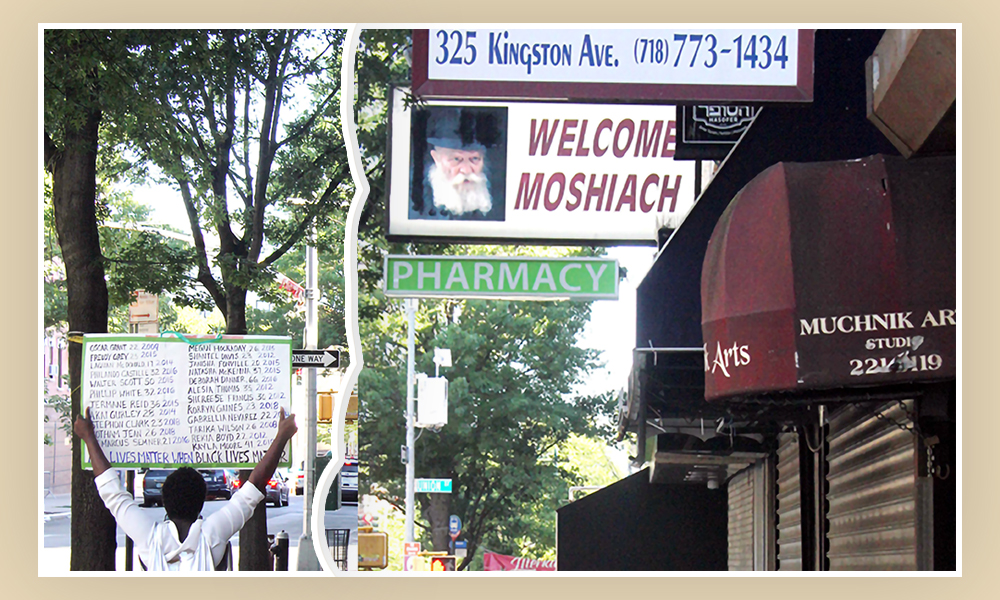


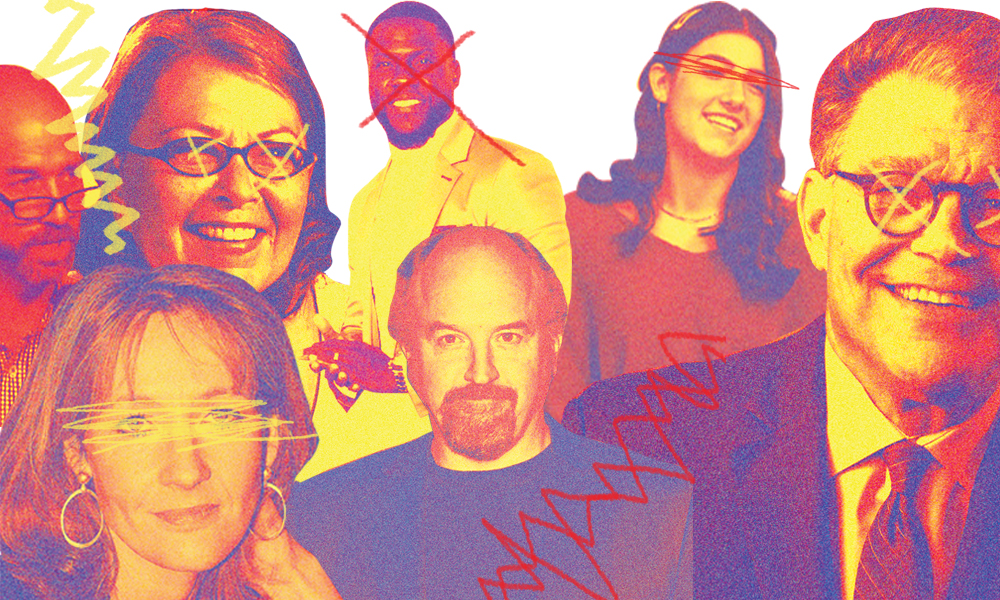


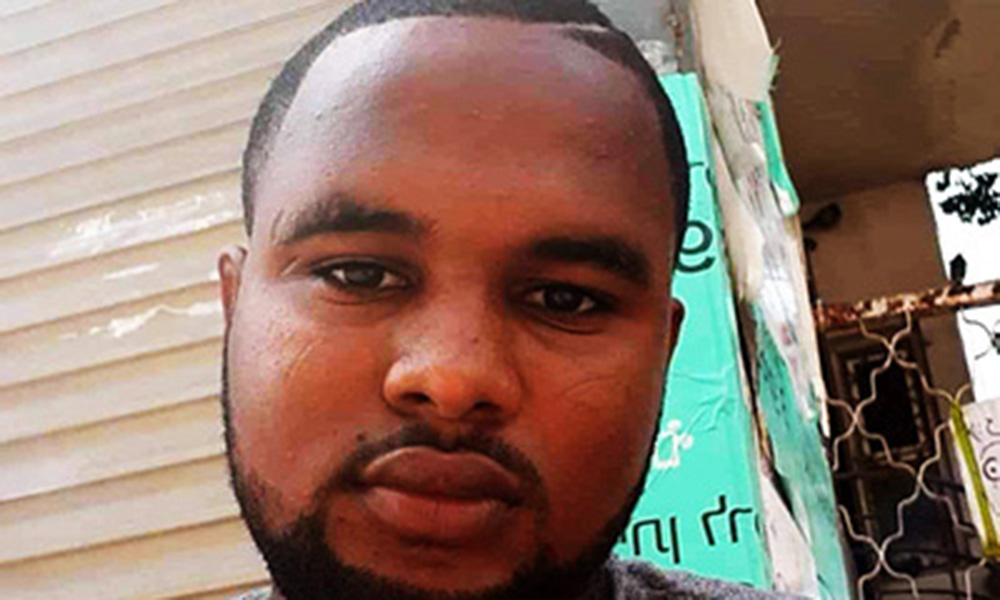

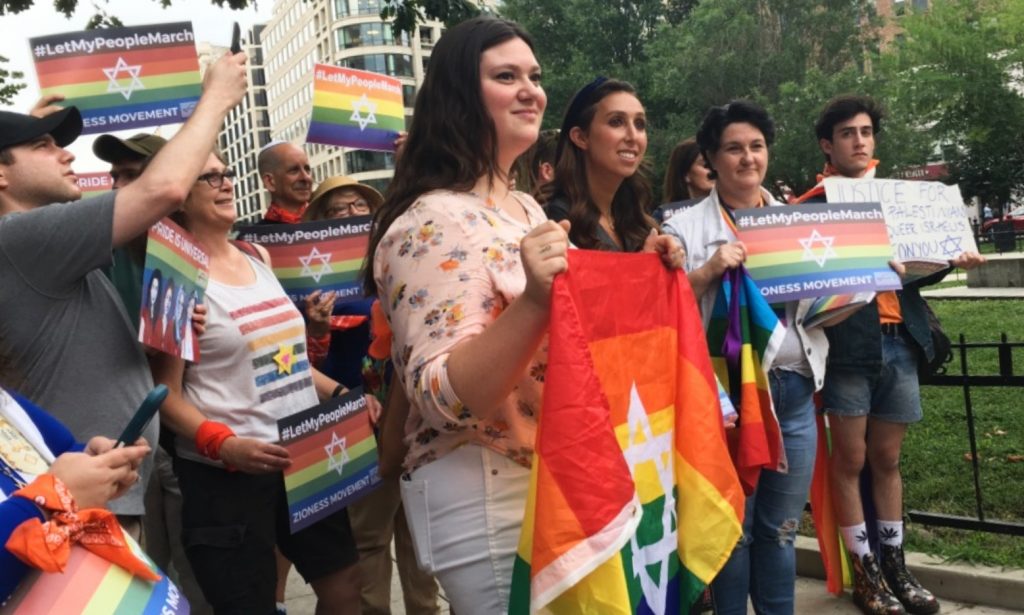
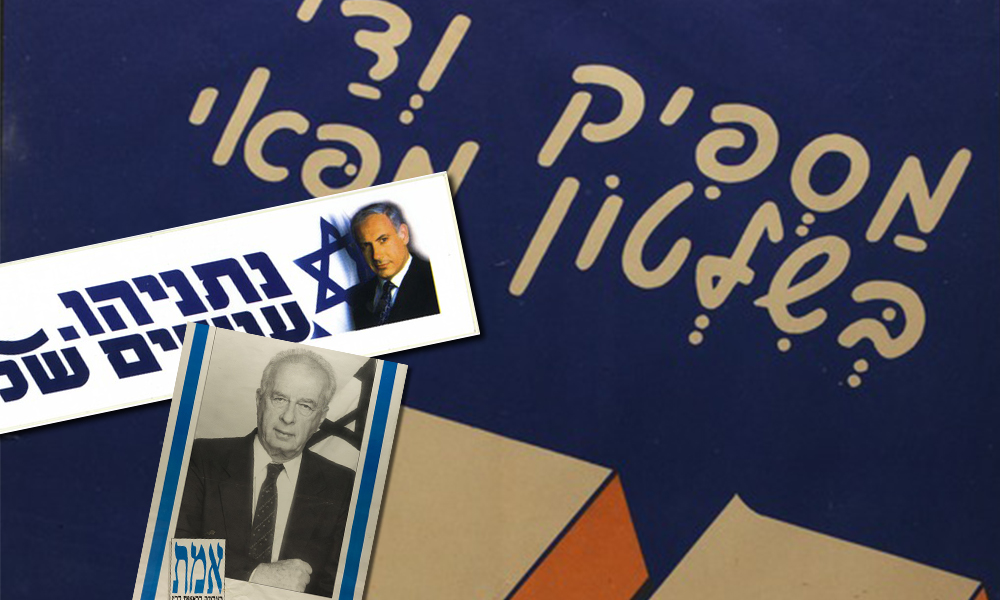
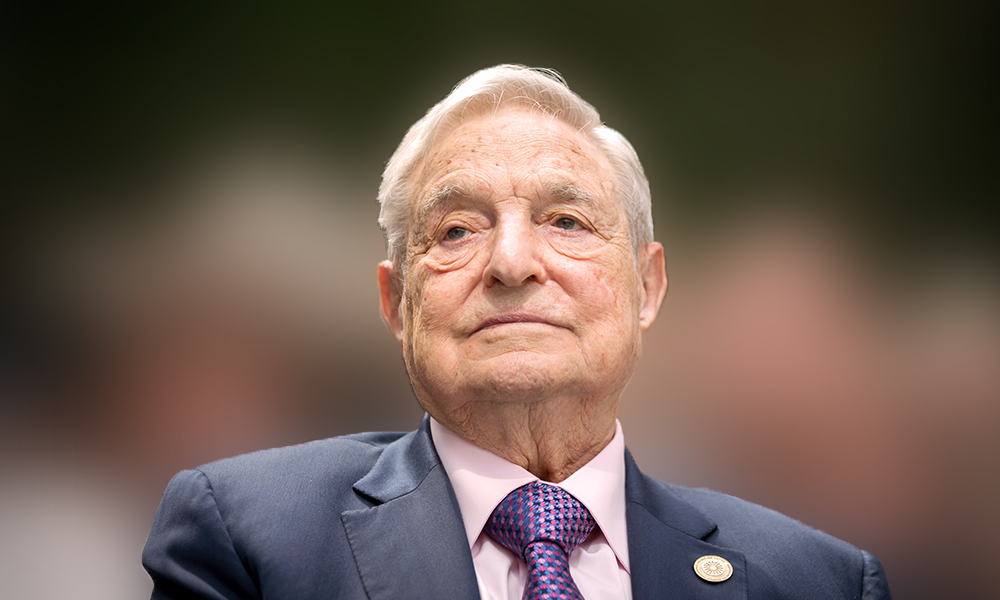
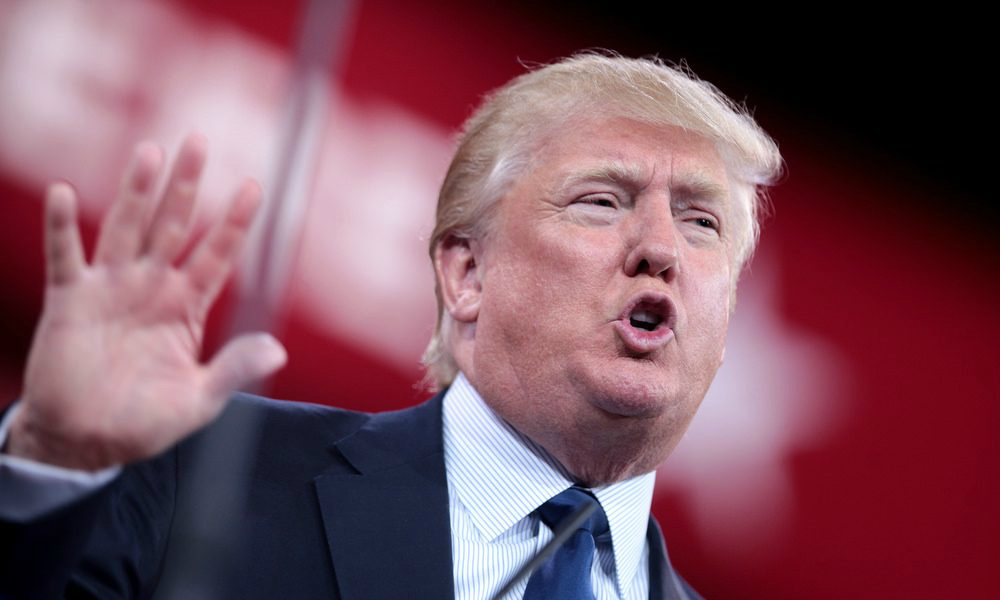
Thank-you Larry for this walk in Crown Heights. I have a version of this story nesting deep in my heart called: What If There Had Been A Jewish Lives Matter Movement in Nazi, Germany? The first lesson Jewish parents should teach a young child is “never to say the N word and then explain why. This is the first lesson I learned from my left wing radical parents Harry and Rhoda Wolfson. In fact, I was named
Paula after Paul Robeson. Our first family home was a dark tiny apartment in the Marcy Housing Project in Brooklyn. 1954. Most of our childhood family friends were Black. Best childhood memories playing in the spray of the fire hydrants on hot summer days. Our family has always lived “in the mix.” From Brooklyn to Compton, CA. Our household had an open door policy and was Command Central for cultivating multicultural relationships. My parent’s friends were often married couples: one Jewish, one Black, children biracial. My America …the one I grew up in…I know…is unusual. However, I believe today’s Black Lives Matter movement, Black film makers, Black journalists, and documentary films such as the “13th” by Ava DuVernay, the compelling book “Caste” by Isabel Wilkerson will continue to wake us up to the current versions of brutal, racist America. Hopefully, Jewish people from various practices and traditions will heed the call and join every BLM that is in their neighborhood. Just imagine if there had been a “Jewish Lives Matter” movement in Nazi, Germany. Now is the time.